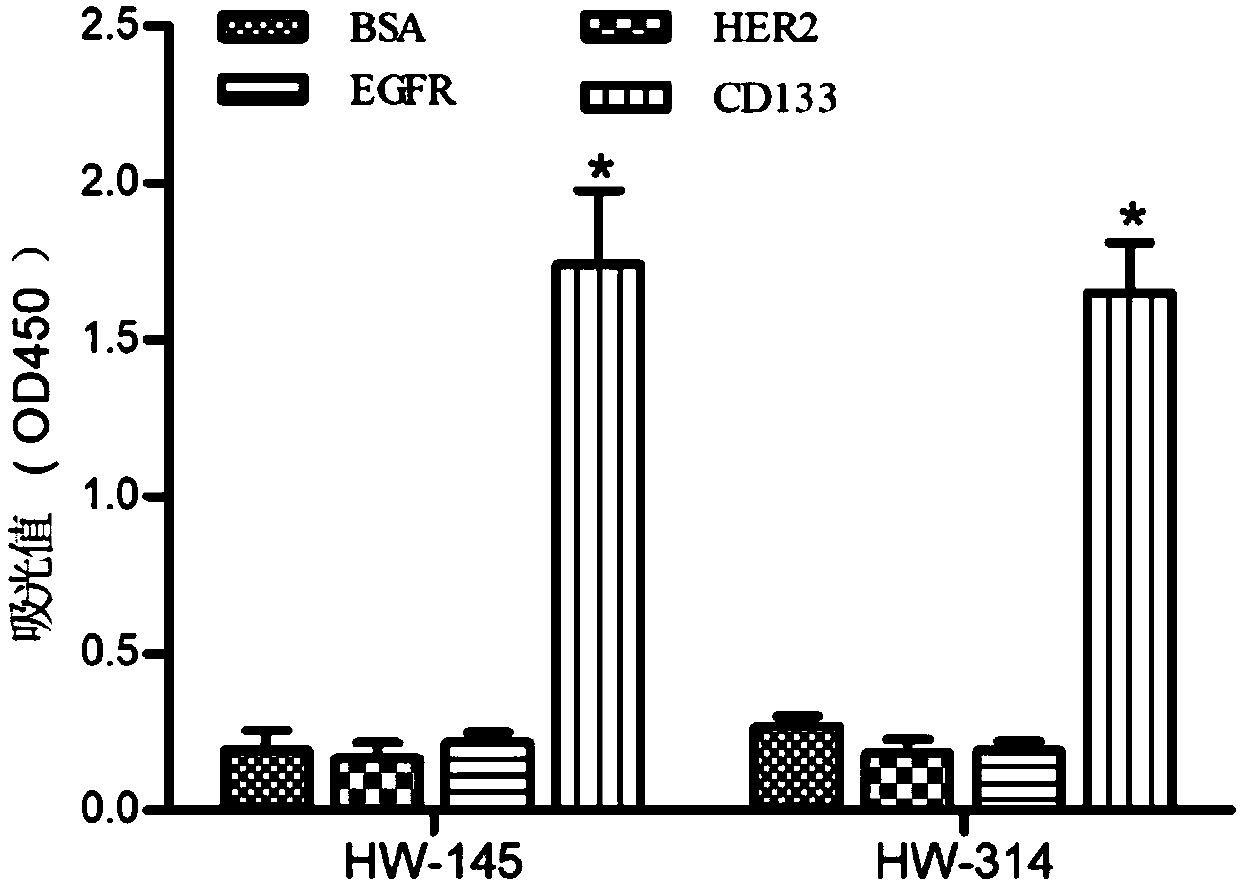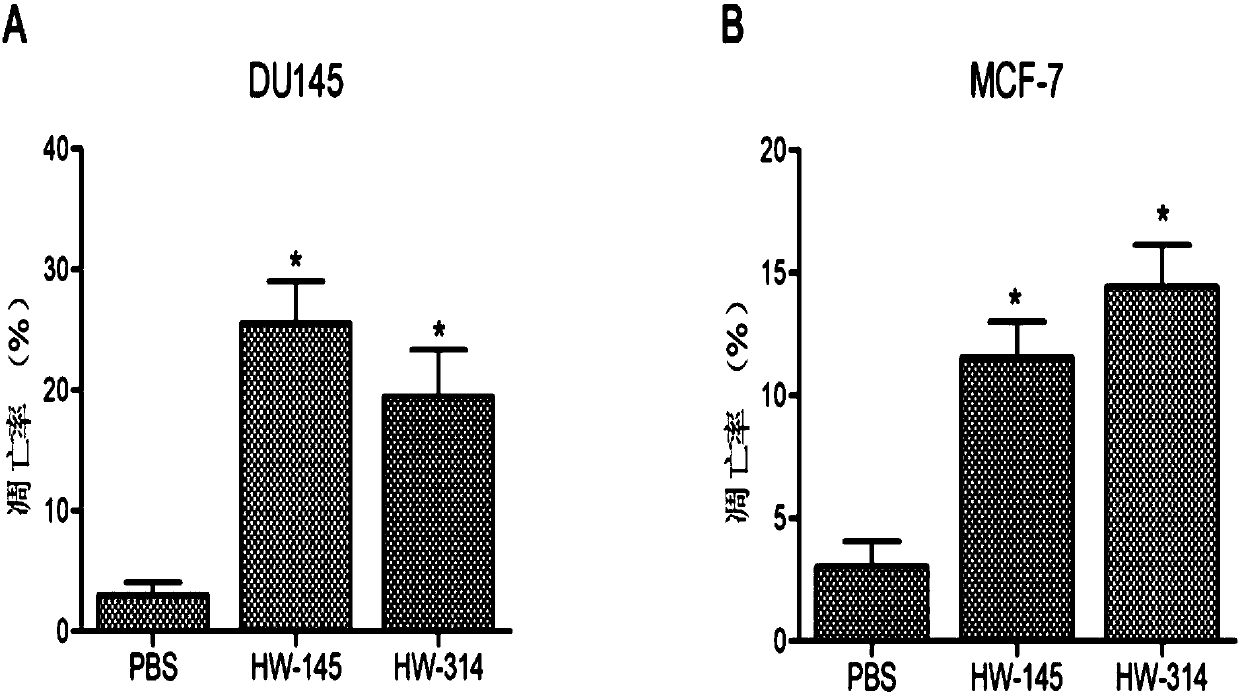Single-domain antibodies against tumor stem cell marker protein CD133 and application thereof
A single-domain antibody, anti-tumor technology, used in anti-tumor drugs, anti-receptor/cell surface antigen/cell surface determinant immunoglobulin, anti-animal/human immunoglobulin, etc., to reduce production costs and molecular weight. Small, structurally stable effect
- Summary
- Abstract
- Description
- Claims
- Application Information
AI Technical Summary
Problems solved by technology
Method used
Image
Examples
Embodiment 1
[0029] Example 1 preparation of helper phage
[0030](1) In a petri dish containing TYE solid medium, spread the TG1 glycerol bacteria purchased from Beyond by the three-zone method, and then place the petri dish in a 37°C constant temperature incubator for 12 to 16 hours;
[0031] (2) Pick a single colony of TG1 grown on TYE solid medium, inoculate it in 5 mL of 2×TY liquid medium, place it on a constant temperature shaker at 37°C, and cultivate it at 250 rpm for 12 to 16 hours;
[0032] (3) Transfer the bacterial culture solution in step (2) to another tube of 5mL 2×TY liquid medium at a ratio of 1:100, place it on a constant temperature shaker at 37°C, and cultivate it at 250rpm until the OD600 of the bacterial solution is about 0.5;
[0033] (4) Dilute the helper phage KM13 with PBS (from 10 12 / mL~10 4 / mL);
[0034] (5) Take 200 μL of the bacterial solution in step (3), add 10 μL of the diluted helper phage KM13 to it, mix well and place in a 37°C water bath for 30 mi...
Embodiment 2
[0042] Example 2 Expression of a phage single domain antibody library
[0043] (1) Take an appropriate amount of phage library (Source Bioscience, product number: 6001_hDAb), add 500mL 2×TY liquid medium (the medium additionally contains 100μg / mL ampicillin, 4% glucose), and culture on a constant temperature shaker at 37°C at 250rpm until the bacteria OD600=0.5;
[0044] (2) Add 2×10 12 A helper phage KM13 to the bacterial solution obtained in step (1), mix well and place in a 37°C water bath for 30 minutes. The 500mL culture was divided into 50mL tubes, centrifuged at 3200g for 10 minutes, the supernatant was discarded, the pellet was resuspended, and transferred to an Erlenmeyer flask containing 500mL of 2×TY liquid medium (the medium additionally contained 0.1% Glucose, 100 μg / ml ampicillin, 50 μg / ml kanamycin). Place in a constant temperature shaker at 25°C and shake at 250rpm for 16-20 hours.
Embodiment 3
[0045] Example 3 Purification of phage single domain antibody library
[0046] (1) Subpackage the overnight culture in Example 2 into 50 mL per tube, and centrifuge at room temperature for 20 minutes at 3200 g;
[0047] (2) Take the centrifuged supernatant and transfer it to another clean 50mL centrifuge tube, add 20% polyethylene glycol solution in a volume ratio of 1:4 to each tube, and incubate on ice for 1 hour;
[0048] (3) Place the centrifuge tube in step (2) at 4°C and centrifuge at 3200 g for 30 minutes, discard the supernatant, resuspend the pellet with 5 mL of PBS, add 1 mL of 20% PEG solution to it, and incubate on ice for 10 minutes;
[0049] (4) Place step (3) at 4°C and centrifuge at 3200g for 30 minutes, discard the supernatant, resuspend the pellet with 1 mL of PBS, then centrifuge at 4°C and 3200g for 5 minutes, and filter the supernatant with a 0.45 μM filter to sterilize;
[0050] (5) Estimate the titer of the phage library by measuring the absorbance at 2...
PUM
 Login to View More
Login to View More Abstract
Description
Claims
Application Information
 Login to View More
Login to View More - R&D
- Intellectual Property
- Life Sciences
- Materials
- Tech Scout
- Unparalleled Data Quality
- Higher Quality Content
- 60% Fewer Hallucinations
Browse by: Latest US Patents, China's latest patents, Technical Efficacy Thesaurus, Application Domain, Technology Topic, Popular Technical Reports.
© 2025 PatSnap. All rights reserved.Legal|Privacy policy|Modern Slavery Act Transparency Statement|Sitemap|About US| Contact US: help@patsnap.com



